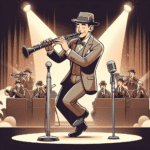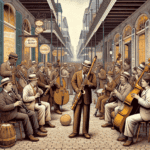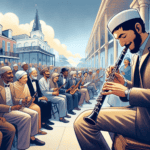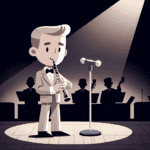The Swing Era, from the 1930s to the 1940s, saw big bands rise to fame and jazz music gain widespread popularity. While trumpets and saxophones often stole the spotlight, clarinets made a lasting impression during this period. Clarinetists added a distinctive voice to swing bands, enhancing the music with their melodic lines and improvisation skills. Let's explore the lives and styles of some of the most influential clarinet players of the Swing Era, highlighting their contributions and the techniques they used.
Benny Goodman: The King of Swing
Benny Goodman stands out as one of the most celebrated figures in swing clarinet. Born in 1909 in Chicago, Goodman rose from modest beginnings to become a jazz icon. He wasn't just a skilled clarinetist; he was also a bandleader who played a key role in making jazz mainstream.
Audiences were captivated by Goodman's precise techniques and musical prowess. His performance at the Palomar Ballroom in 1935 is often seen as the spark that ignited the Swing Era. Goodman's unique approach blended classical elements with improvisation, creating a sound all his own. His exceptional breath control allowed him to play long phrases without interruption.
Benny Goodman's Signature Style
- ? Precise technique
- ? Blend of classical and jazz elements
- ? Exceptional breath control
- ? Mastery of vibrato and rhythmic articulation
- ? Seamless transitions between legato and staccato
Goodman's playing was characterized by his unique combination of vibrato and rhythmic articulation. His ability to smoothly transition between legato passages and staccato notes demonstrated his mastery of the clarinet and solidified his position as a leading figure in jazz.
Artie Shaw: The Innovator
Artie Shaw, another clarinet giant of the Swing Era, was born in 1910 and quickly gained recognition for his distinctive style and sophisticated arrangements. Unlike Goodman, Shaw's background spanned both classical music and jazz, allowing him to merge influences in creative ways. His band featured a diverse range of instruments, showcasing forward-thinking arrangements.
Shaw's recordings, such as “Begin the Beguine,” showcased his talent for beautifully blending classical and jazz elements. His clarinet playing was known for its smooth, rich tone and exceptional technical prowess. Shaw also introduced new techniques like flutter tonguing, expanding the expressive capabilities of the clarinet.
Buddy DeFranco: Pioneering the Bebop Style
While later renowned for his bebop clarinet work, Buddy DeFranco was also a notable figure in the Swing Era. His knack for improvising intricate lines with great skill made him stand out. DeFranco's innovative approach to clarinet improvisation allowed him to blend seamlessly with the big band sound.
Technical Aspects of Swing Era Clarinets
Although clarinet players in the Swing Era used various techniques, certain common characteristics defined their style:
| Technique | Description |
|---|---|
| Articulation | Swing clarinetists mixed staccato and legato articulations, enabling dynamic expression in solos. |
| Vibrato | A controlled vibrato added warmth and character to the clarinet sound, contributing to the rich tone associated with big band arrangements. |
| Melodic Variation | Clarinetists often used melodic variations through improvisation, showcasing their creativity alongside harmonies. |
Influence on Future Generations
The impact of Swing Era clarinet players continues to be felt in jazz today. Their contributions shaped the clarinet's role in various musical contexts. Through their innovative techniques and influences, new artists in the genre continue to find inspiration in these iconic musicians.
The fusion of classical technique with jazz improvisation paved the way for future artists to explore these genres and consistently push the boundaries of clarinet performance.
Impact on Jazz and Popular Music
As the Swing Era set the stage for various musical genres, the clarinetists of this period were instrumental in driving this change. They not only won over audiences with their skilled performances but also shaped popular music trends of the time.
Following the Swing Era, many of these players became teachers, nurturing the next generation of talent and ensuring the clarinet remained an important instrument in jazz.
In an ever-changing musical landscape, the clarinet's prominence during the Swing Era showcases its versatility and lasting appeal. Talented musicians like Goodman, Shaw, and DeFranco blazed trails during the Swing Era, proving that the clarinet could create enchanting sounds that stand the test of time.







